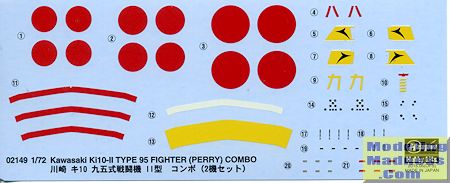
Hasegawa 1/72 Kawasaki Ki-10-II Type 95 Combo
| KIT #: | 02149 |
| PRICE: | 2560 yen from www.hlj.com |
| DECALS: | Three Options |
| REVIEWER: | Scott Van Aken |
| NOTES: |

| HISTORY |
The Ki-10 was designed by Japanese aeronautical engineer Takeo Doi, who had succeeded Richart Vogt as chief designer for Kawasaki. The design was in response to a requirement issued by the Imperial Japanese Army for a new fighter, and was the winner of a competition against Nakajima's Ki-11. Although the low-wing monoplane offered by Nakajima was more advanced, the Army preferred the more maneuverable biplane offered by Kawasaki.
The Kawasaki design had unequal-span wings, braced by struts, and with upper-wing ailerons. The structure was of all-metal construction, which was then fabric-covered. Armament consisted of two 7.7 mm (.303 in) Type 89 machine guns, synchronized to fire through the propeller. The initial production version was powered by a liquid-cooled 633 kW (850 hp) Kawasaki Ha-9-IIa V engine.
The Ki-10 was deployed in Manchuria and in the initial campaigns of the Second Sino-Japanese War in northern China. It proved an excellent dogfighter against the Chinese air force, including at the Battle of Wuhan. However, by the time of the Nomonhan Incident in 1939, against the forces of Soviet Russia, it was largely obsolete.
At the beginning of the Pacific War, the Ki-10 was retired to training and secondary missions, but later returned to front-line service, performing short-range patrol and reconnaissance missions in Japan proper and China in January-February, 1942.
| THE KIT |
When I first saw this kit offered, I knew that Hasegawa did not make a Ki-10. This meant it was a rebox and Fine Molds came to mind as they are both Japanese kit makers. I was surprised when I opened the box to find a pair of ICM kits. This is not a bad thing as ICM's Ki-10 kit is actually quite nice. One does have to be careful removing bits from sprues as the sprue gates often impinge on the parts themselves. In one case, the trailing edge of the wings, stress sections are clearly visible and so one has to be very careful not to to have chunks removed when separating the wing from sprue. The kit comes on a single grey sprue and there are mold seams to clean up.
The kit itself is very simple as these things go. Interior is a floor, rudder pedals, stick and seat back. There is some framing detail on the interior side wall. ICM has chosen to use a piece of acetate for the windscreen. This must be cut out, folded and a hole drilled in it for the gun sight tube. Attachments for the various struts consist of small indentations on the wings and fuselage. This should be adequate, though some may want to drill them out a bit more.
 Instructions
are very well done with four major construction steps. Each drawing provides
color information where it is required using Gunze paints. A full rigging
diagram is provided and using this in conjunction with the box art
should be most helpful. Markings are for three aircraft with insignia for two.
The first plane on the box art is in overall grey-green. This is with the 2nd
Air Battalion in China in 1937 and flown by Lt. Kawahara. The camouflaged plane
was with the 77th Flight Regiment in 1939, and a third option is an overall grey
-green plane with the 2nd Air Battalion in China during 1937 and flown by Capt
Tateo Kato. The decals are quite nicely done and include instrument panel
markings.
Instructions
are very well done with four major construction steps. Each drawing provides
color information where it is required using Gunze paints. A full rigging
diagram is provided and using this in conjunction with the box art
should be most helpful. Markings are for three aircraft with insignia for two.
The first plane on the box art is in overall grey-green. This is with the 2nd
Air Battalion in China in 1937 and flown by Lt. Kawahara. The camouflaged plane
was with the 77th Flight Regiment in 1939, and a third option is an overall grey
-green plane with the 2nd Air Battalion in China during 1937 and flown by Capt
Tateo Kato. The decals are quite nicely done and include instrument panel
markings.
| CONCLUSIONS |
For those working in 1/72 whose penchant is inter-war aircraft, this is a must have to add to the collection. Interestingly, the price of this set in Japan is less than two ICM kits in the US.
| REFERENCES |
http://en.wikipedia.org/wiki/Ki-10
July 2015
You can find this and other interesting kits and accessories at
www.hlj.com. Pick up this one
at this link. If you would like your product reviewed fairly and quickly , please
contact
me or see other details in the
Note to
Contributors.